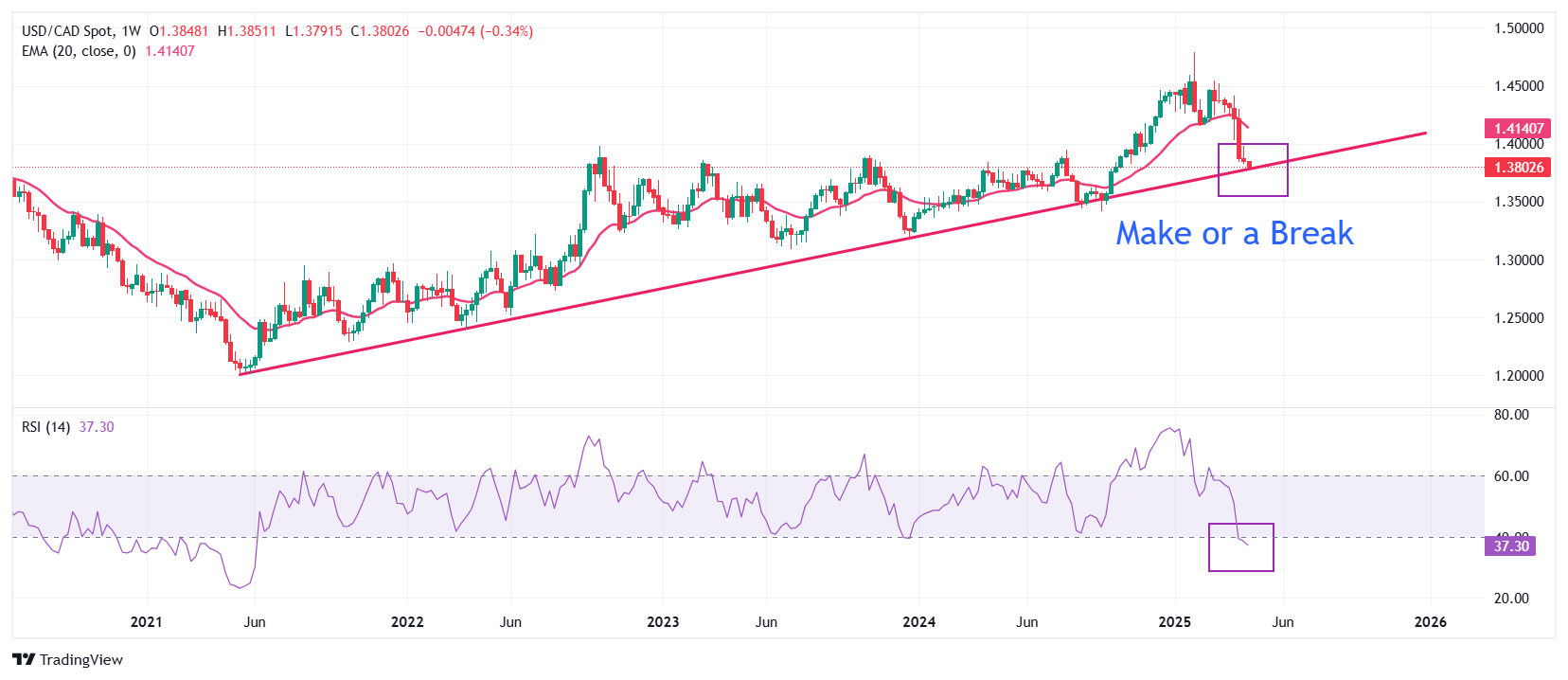USD/CAD Price Forecast: Declines to near 1.3800 as US Dollar nosedives
- USD/CAD falls to near 1.3800 due to a significant weakness in the US Dollar.
- US President Trump mulls over firing Fed Powell for not cutting interest rates.
- Canadian PM Carney pledges tax cuts and defense spending.
The USD/CAD pair slides to near 1.3800 in Monday’s European session, the lowest level seen in six months. The Loonie pair slumps as the US Dollar (USD) underperforms its peers, with the Federal Reserve (Fed) under threat from United States (US) President Donald Trump. The US Dollar Index (DXY), which tracks the Greenback’s value against six major currencies, plunges to a fresh three-year low near 98.00.
The Greenback continues to face pressure as doubts over its safe haven status have escalated with US President Trump aiming to remove Fed Chair Jerome Powell for not reducing interest rates and guiding a “wait and see” mode on sticky consumer inflation expectations.
The credibility of the US Dollar was already challenged by ever-changing statements from Donald Trump on his tariff policies, which clouded the uncertainty over the global economic outlook, including the US.
Meanwhile, the uncertainty over Trump’s protectionist policies could diminish as Washington has expressed optimism over a US-China trade deal. “We're confident it will work out with China,” US Commerce Secretary Howard Lutnick said over the weekend.
In the Canadian region, Prime Minister Mark Carney vows tax cuts and an increase in defense spending to ease reliance on the US in the face of Trump’s tariff policies. Such a scenario will stimulate economic growth.
USD/CAD trades at a make-or-break level near the upward-sloping trendline around 1.3800, which is plotted from the May 2021 low of 1.2031 on a weekly timeframe.
The 20-week Exponential Moving Average (EMA) has started declining near 1.4140, suggesting that the trend is weak.
The 14-week Relative Strength Index (RSI) falls below 40.00 for the first time in almost four years. A fresh bearish momentum would trigger if it stays below the 40.00 level.
More downside towards the psychological support of 1.3500 and the September 24 low of 1.3430 looks likely if the pair breaks below the round-level figure of 1.3600.
In an alternate scenario, a recovery move by the pair above the psychological level of 1.4000 will support it to move further to near the April 9 low of 1.4075, followed by the April 8 low of 1.4272.
USD/CAD weekly chart

US Dollar FAQs
The US Dollar (USD) is the official currency of the United States of America, and the ‘de facto’ currency of a significant number of other countries where it is found in circulation alongside local notes. It is the most heavily traded currency in the world, accounting for over 88% of all global foreign exchange turnover, or an average of $6.6 trillion in transactions per day, according to data from 2022. Following the second world war, the USD took over from the British Pound as the world’s reserve currency. For most of its history, the US Dollar was backed by Gold, until the Bretton Woods Agreement in 1971 when the Gold Standard went away.
The most important single factor impacting on the value of the US Dollar is monetary policy, which is shaped by the Federal Reserve (Fed). The Fed has two mandates: to achieve price stability (control inflation) and foster full employment. Its primary tool to achieve these two goals is by adjusting interest rates. When prices are rising too quickly and inflation is above the Fed’s 2% target, the Fed will raise rates, which helps the USD value. When inflation falls below 2% or the Unemployment Rate is too high, the Fed may lower interest rates, which weighs on the Greenback.
In extreme situations, the Federal Reserve can also print more Dollars and enact quantitative easing (QE). QE is the process by which the Fed substantially increases the flow of credit in a stuck financial system. It is a non-standard policy measure used when credit has dried up because banks will not lend to each other (out of the fear of counterparty default). It is a last resort when simply lowering interest rates is unlikely to achieve the necessary result. It was the Fed’s weapon of choice to combat the credit crunch that occurred during the Great Financial Crisis in 2008. It involves the Fed printing more Dollars and using them to buy US government bonds predominantly from financial institutions. QE usually leads to a weaker US Dollar.
Quantitative tightening (QT) is the reverse process whereby the Federal Reserve stops buying bonds from financial institutions and does not reinvest the principal from the bonds it holds maturing in new purchases. It is usually positive for the US Dollar.


